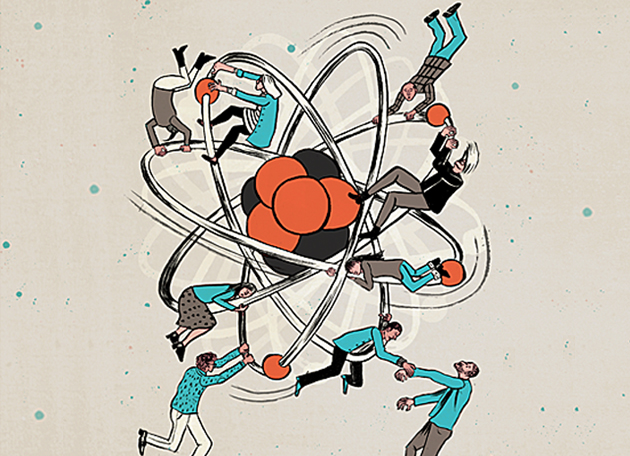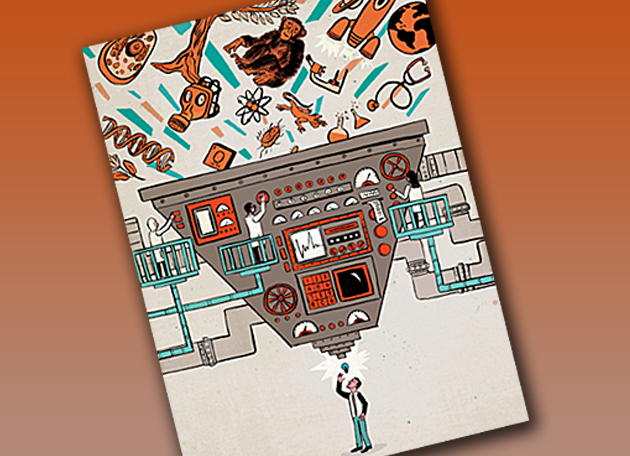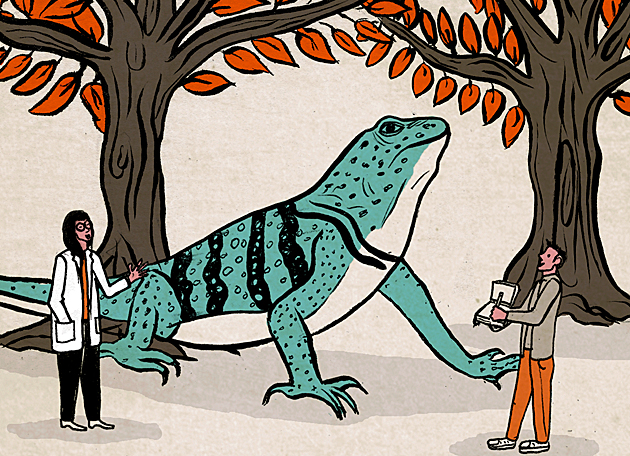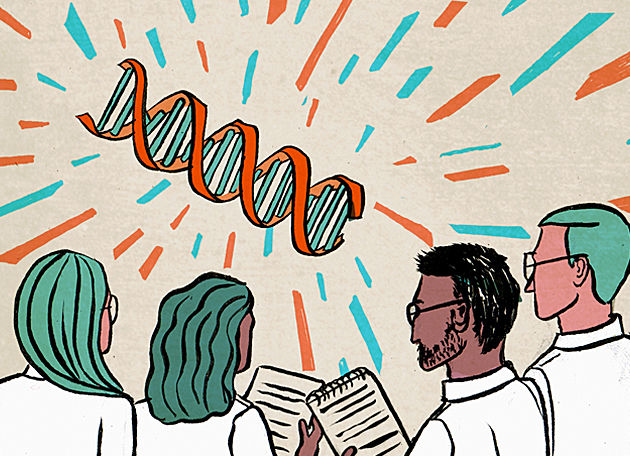
Eastern collared lizards are striking creatures. The distinctively marked reptiles can grow to a foot in length, and when they hoist themselves up on their hind legs to chase their prey, they look like tiny dinosaurs. But in the late 1970s, they were disappearing. In parts of the Ozark Mountains, for example, an increasing number of eastern red cedar trees shaded areas that once had been open. The lizards, which need to bask in the sun to get energy to hunt, were dying out.
Alan Templeton, PhD, the Charles Rebstock Professor of Biology in Arts & Sciences, eagerly undertook the mission to bring them back to the area, and he proposed the following solution: setting fire to the dense vegetation to clear out these once-open areas. Not only would a controlled burn give the lizards a place to sun themselves, but it would eliminate some of the non-native vegetation that was competing with endangered plants, improve forage for grazing mammals, and enhance timber quality.
“You have to be able to communicate the complexity of conservation, but do it in a way that is relevant to people, and that makes them a part of the equation.”
—Alan Templeton, PhD
The science made sense, but local residents understandably were concerned. Was it dangerous? Would it affect their livelihoods? Was a lizard really worth all that effort?
Templeton made his case for the lizard, but he also pointed out benefits that others would see through fire management. “I was able to persuade turkey hunters to get on board, because I could show them that a burned forest produced more food and forage for turkeys than a non-burned forest. I could also show that periodic forest fires actually helped the lumber quality and value,” he says. “You have to be able to communicate the complexity of conservation, but do it in a way that is relevant to people, and that makes them a part of the equation.”
It took time, but the conversations took hold. In the early 1980s, Templeton and members of the Missouri Department of Conservation performed small, prescribed fires. Later, they did landscape-sized burns, expanding into adjacent properties owned by the Nature Conservancy and National Park Service.
The collared lizard has since re-colonized the area, and turkey and deer populations have increased as well. Most recently elk have been re-introduced into this area due to the burning. “I’m so pleased with the way things are going,” Templeton says. “We’ve made so much progress.”
A 2007 study found that just 28 percent of Americans are scientifically literate, with few knowing even the most basic scientific concepts.
Scientific ideas can be complicated, and sometimes they can upend our understanding of the world. But that doesn’t mean they can be disregarded; in fact, the potential consequences of ignorance are only getting more serious. Need proof? Look only as far as our nation’s capital. Scientists nearly universally agree about the existence and importance of climate change, and say it’s a likely contributor to extreme weather events such as the recent Superstorm Sandy. Nonetheless, some politicians’ ignorance of climate change’s reality, willful or otherwise, has stalled policy efforts to slow its progress.
Right now, the United States occupies a precarious spot. Once a science and technology leader, it is no longer the powerhouse it once was. A 2007 study found that just 28 percent of Americans are scientifically literate, with few knowing even the most basic scientific concepts. Moreover, the pipeline for future scientists and scientifically literate citizens proves uncertain. American students rank 17th among the 30 wealthiest nations in their ability to apply math and science concepts to real-life contexts.
With this alarming trend as the backdrop, many Washington University faculty are stepping forward and working to help all people — from kindergartners to senior citizens — truly understand what science is, how it works, and how it can be used to improve lives and the world.

New Framework for Science Education
Many people profess that they just “don’t get” science — a problem they may trace back to dull lectures and poorly explained concepts from their days as students. Several Wash. U. faculty members are countering decades of dull pedagogy to make science more relevant, engaging and meaningful to students of all ages.
Michael Wysession, PhD, associate professor of earth and planetary sciences in Arts & Sciences, for example, believes that it’s time to fire science teachers — and turn them into science coaches. If anyone possesses the credentials to take this bold stance, it’s Wysession. In addition to authoring more than 20 textbooks, he is chair of the National Science Foundation (NSF)-funded Earth Science Literacy Initiative (ESLI). (The ESLI, in its 2009 Earth Science Literacy Principles, codified the “big ideas” and supporting concepts that all Americans should know about Earth sciences.) Wysession also is a leader for a National Research Council project to create a new framework for K–12 science education. “Science shouldn’t be about giving students 100 things to learn and then giving them an ‘A’ on a multiple-choice test if they can remember 90 of them,” he says.
“Studies show that students who participate in the practice of science enjoy it more, retain the information longer, and more often pursue science as a career.”
—Michael Wysession, PhD
Instead, teachers who think of themselves as coaches, who help their students “practice” science, approach their work in a fundamentally different way. Instead of telling students to read about how rocks can form by precipitation or the compaction of sediments, or even by the actions of living organisms, teachers might ask students to design experiments to try to model this. “Studies show that students who participate in the practice of science enjoy it more, retain the information longer, and more often pursue science as a career,” Wysession says.
Over time, and through the work of his committees and others, this inquiry-based approach is likely to replace much of the memorization-based science teaching that lingers in schools.
Of course, not every scientific concept can be replicated easily. (Good luck to any physics professor trying to replicate the big bang in the classroom.) But that doesn’t mean students shouldn’t have to grapple deeply with difficult scientific ideas.
Just ask Kathy Miller, PhD, professor of biology in Arts & Sciences. Miller, also chair of the biology department, spent her first years teaching developmental biology just as she had learned it: lecturing and administering tests. When the results suggested that students weren’t absorbing her lessons, she looked for a better approach. She found it through writing.
So instead of teaching them the parts of the cell and the definitions of a few processes, she requires her students to write essays that combine book learning, lessons gleaned from lab experimentation and class discussion. The act of combining these various learning experiences into a work of lengthy writing crystallizes the knowledge.
“[Writing] requires you to synthesize hypotheses in a coherent way,” she says. “[It’s] how we wrestle with ideas.” Further, in her class, students work in groups and do presentations; they forego the typical memorizing and test-taking.
She says it’s made a vast difference. “Teaching facts compared with teaching students how to put ideas together is analogous to giving someone a fish versus teaching that person to fish,” she says. “When students know how to find, gather and use information — when they can solve problems for themselves — they not only understand what science is, but they can use [these strategies] years from now. And that’s more important than knowing individual facts from the course.”
Today, Miller shares this approach with a broader audience. She is one of 40 leaders nationwide developing initiatives to catalyze the adoption of Vision and Change in Undergraduate Biology Education, issued by the NSF and American Academy of Arts & Sciences. Hundreds more are following her charge.
“The challenge of science literacy is the multiplier. We know a lot about how to teach science effectively. But we need to do that for lots of people, and we need to do it consistently.”
—Sarah C.R. Elgin, PhD
Sarah C.R. Elgin, PhD, the Viktor Hamburger Professor in Arts & Sciences, has taken a different approach to a similar problem. More than a decade ago, she decided that instead of teaching students about the research that scientists do, she would enable students in her courses to become research scientists themselves.
Elgin’s area of expertise is in chromosome organization and regulation, and she makes extensive use of genomics, a branch of molecular biology. This messy and data-heavy field requires both the brute force of computers and fine-tuning from humans. After receiving a crash course in genomics and databases, her undergraduate students have the tools they need to analyze the dot chromosome of a specific species of fruit fly from the genus Drosophila. They dig through the acres of unexplored data and find meaningful bits among the genetic dross. Because the work her students do is real research — not a recipe-like experiment with a predetermined outcome that’s been done for generations — they’re engaged in science in a way that no lecture can match.
But the real genius of Elgin’s work is not just giving undergraduates meaningful research that teaches them the principles of science, but helping others replicate this approach through the Genomics Education Partnership.
“The challenge of science literacy is the multiplier,” Elgin says. “We know a lot about how to teach science effectively. But we need to do that for lots of people, and we need to do it consistently.”
Because much of genomics education requires nothing more than a computer, professors from schools across the country have been able to add it to their slate of classes. Biology faculty are looking for ways to incorporate genomics into their curriculum and like the research orientation. To date, Elgin’s genomics research projects have been incorporated into classes at more than 100 schools, with more added every year. (Elgin is also responsible for other important education efforts, including founding WUSTL’s Science Outreach two decades ago. The program, currently run by Victoria May, PhD, director of the Institute for School Partnership, is designed to enhance science education for those in elementary and secondary school.)

From Knowledge to Action
Understanding science is important, and making real changes based on that information — the point where ideas meet reality — is vital.
So says Matthew Kreuter, PhD, MPH, professor at the Brown School and School of Medicine, who spends much of his time helping people make good health-care decisions. His research has found that good health practices, such as regular mammograms, can be encouraged by describing their importance in culturally relevant ways.
“Our goal is to take what we know from science and make it applicable and meaningful. We want to make science something that people can learn from and act upon.”
—Matthew Kreuter, PhD, MPH
He cites the example of improving the rates of mammography among African-American women by showing how getting screened for breast cancer reinforces cultural values of faith and family. Helping women make these linkages elevates mammography from an abstract medical procedure to a conscious decision that is consistent with a person’s life priorities.
Kreuter says that medical providers should work within these types of cultural contexts. “If someone has faith as the center of her identity, we would talk about mammograms in the context of that faith,” he says. “[We might say that] ‘the Lord has given us a powerful tool to find breast cancer early, when it has the best chance of being treated effectively. So, getting a mammogram, together with the power of prayer, gives you the best chance to lead a long and healthy life in the service of God.’”
In his studies, messages like this connected: Women who heard ideas framed in this way were 2.6 times more likely to get a mammogram than a control group.
Such results can be extrapolated to different groups of people and different goals. “Our goal is to take what we know from science and make it applicable and meaningful,” he says. “We want to make science something that people can learn from and act upon.”
Helping people make better decisions through smarter messaging also resonates with Jay Turner, DSc, associate professor of energy, environment and chemical engineering in the School of Engineering & Applied Science. Turner was a founding co-chair of the St. Louis Regional Clean Air Partnership (SLRCAP) in 1994. In this capacity, he aimed to educate the citizenry about air quality in the city, which could be downright dangerous some days. “Death certificates don’t say that ‘Joe died from air pollution,’” Turner says. “But when someone dies of congestive heart failure or a chronic obstructive pulmonary disease, air pollution may have been [a significant contributor] to that death.”
During his tenure at SLRCAP, Turner guided the partnership’s efforts to get media to broadcast air-quality reports and to put up a traffic-signal-like light on Interstate 64 near the Saint Louis Science Center that indicated when air quality was bad (red) or when it was good (green). The partnership promoted educational campaigns so people knew that when air quality was bad, they should carpool and avoid exercising outside. Surveys indicated increased public awareness about air quality and its impacts.
According to recent EPA data, this two-decade effort has made a difference. “Our air quality — both here in St. Louis and in general in the United States — has improved dramatically, in part because of such voluntary measures taken by the citizenry,” he says.

Science Key to Addressing Challenges
With so much at stake, improving our nation’s scientific literacy remains an enormous, consequential task. Washington University faculty members, by creating smart approaches to solving problems, are impacting the conversation across ages and areas.
With so much at stake, improving our nation’s scientific literacy remains an enormous, consequential task. Washington University faculty members, by creating smart approaches to solving problems, are impacting the conversation across ages and areas.
They’re also educating future leaders and decision makers in an era in which science will be central to addressing some of the most challenging problems, Miller says. “When looking at the problems we face — climate, energy, the environment, food, health — these are all about science,” she says. “It’s not enough to say: ‘Well, I can’t understand that. I’m going to have to let somebody else decide for me.’ We need to understand implications so we can make the best possible decisions.”
Erin Peterson is a freelance writer based in Minneapolis and a first-time contributor to Washington.
For more on earth and planetary science professor Michael Wysession, read his Jan. 8 blog post at the Scientific American, “Why America’s Kids Need New Standards for Science Education.”